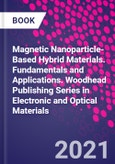Magnetic Nanoparticle-Based Hybrid Materials: Fundamentals and Applications introduces the principles, properties, and emerging applications of this important materials system. The hybridization of magnetic nanoparticles with metals, metal oxides and semiconducting nanoparticles may result in superior properties. The book reviews the most relevant hybrid materials, their mechanisms and properties. Then, the book focuses on the rational design, controlled synthesis, advanced characterizations and in-depth understanding of structure-property relationships. The last part addresses the promising applications of hybrid nanomaterials in the real world such as in the environment, energy, medicine fields.
Magnetic Nanoparticle-Based Hybrid Materials: Fundamentals and Applications comprehensively reviews both the theoretical and experimental approaches used to rapidly advance nanomaterials that could result in new technologies that impact day-to-day life and society in key areas such as health and the environment. It is suitable for researchers and practitioners who are materials scientists and engineers, chemists or physicists in academia and R&D.
Please Note: This is an On Demand product, delivery may take up to 11 working days after payment has been received.
Table of Contents
Part I�Basic principles1.�Magnetic nanoparticles: synthesis and characterization
Ladan Rashidi
2.�Magnetic nanoparticles: fabrication, characterization, properties, and application for environment sustainability�
Paritosh Patel, Aditya Nandi, Ealisha Jha, Adrija Sinha, Swabhiman Mohanty, Pritam Kumar Panda, Suman Mishra, Suresh K. Verma and Mrutyunjay Suar
3.�Ferrite-gold magnetoplasmonic nanohybrids for bimodal heating by magnetic hyperthermia and photothermia�
Enzo Bertuit and Ali Abou-Hassan
4.�Magnetic polymer hybrid nanomaterials�
Anca Florea, Bogdan Feier, Mihaela Tertis, Oana Hosu, Adrian Blidar and Cecilia Cristea
5.�Hybrid Magnetic nanoparticles Carbonaceous nanomaterials (carbon nanotube/graphene)�
Seyyed Mojtaba Mousavi, Khadije Yousefi, Seyyed Alireza Hashemi and Sonia Bahrani
6.�Magnetic nanoparticle-polymer hybrid materials�
Samaa Salem and Erkan Yilmaz
7.�Magnetic nanoparticle-polymer nanohybrids�
Marziyeh Fathi, Elaheh Dalir Abdollahinia, Nazanin Amiryaghoubi, Hossein Omidian and Yadollah Omidi
8.�Magnetic nanomaterial turbulent flow considering ferrohydrodynamics�
M. Sheikholeslami, M. Jafaryar, Mikhail A. Sheremet and Ahmad Shafee
9.�Magnon-electron interaction in magnetic nanoparticle-based hybrid materials
Nahid Ahmadi and Ali Ramazani
Part II�Biomedical applications�
10.�Biomedical applications of magnetic hydrogels�
Mari C. Ma�as-Torres, Cristina Gila-Vilchez, Juan D.G. Dur�n, Modesto T. Lopez-Lopez and Luis �lvarez de Cienfuegos
11.�Coprecipitation synthesis, stabilization, and characterization of oleic acid-coated iron oxide nanoparticles for magnetically oriented hybrid system vectorization
Maria In�s Ferreira, T�nia Cova, Jos� A. Paix�o, Alberto Pais and Carla Vitorino
12.�Magnetic nanoparticles-based hybrid materials for hyperthermia cancer treatments
Laura M. Sanchez
13.�Magnetic hybrid nanoparticles for drug delivery
Swati Singh, Harshita Chawla, Amrish Chandra and Seema Garg
14.�Hybrid magnetic nanoparticles for multimodal molecular imaging of cancer�
Yurena Luengo Morato, Marzia Marciello, Laura Lozano Chamizo, Karina Ovejero Paredes and Marco Filice
15.�Magnetic nanoparticle-based hybrid materials in the biomedical field: fundamentals and applications
Kwaku Baryeh, Mohammed Attia, Joshua Chaj Ulloa and Jing Yong Ye
16.�Magnetic nanoparticles in cancer therapy
Mohsen Khodadadi Yazdi, Payam Zarrintaj, Ali Khodadadi, Mohammad Reza Ganjali, Babak Bagheri, Sajjad Habibzadeh, Mohammad Reza Saeb and Masoud Mozafari
17.�Medical applications of multifunctional magnetic nanoparticles
Ayuob Aghanejad, Hossein Omidian and Yadollah Omidi
18.�Biomedical applications of magnetic nanoparticles
Muzahidul I. Anik, M. Khalid Hossain, Imran Hossain, Isteaque Ahmed and Rashed M. Doha
Part III�Environmental applications
19.�Antimicrobial activity of hybrid organic-inorganic core-shell magnetic nanocomposites�
Dmitry Zablotsky, Izolda Segal, Alla Zablotskaya, Mikhail Maiorov and Tuan Anh Nguyen
20.�Environmental applications of magnetic nanoparticles
Ilgook Kim, Hee-Man Yang, Chan Woo Park, In-Ho Yoon and Youngho Sihn
21.�Magnetic nanoparticles in wastewater treatment�
Javad Farahbakhsh, Vahid Vatanpour, Mohammad Reza Ganjali and Mohammad Reza Saeb
22.�Magnetic hybrid nanoparticles for environmental remediation�
Elvis Ikechukwu Nosike, Yujie Zhang and Aiguo Wu
Part IV�Applications for sensor, catalysis and analytical processes
23.�Magnetic hybrid nanocatalysts
Reza Taheri-Ledari and Ali Maleki
24.�Magnetic hybrid nanoparticles for improvements in analytical processes
Rosa Carmen Rodr�guez Mart�n-Doimeadios, �ngel R�os, Francisco Javier Guzm�n Bernardo and Mohammed Zougagh
25.�Hybrid magnetic nanoparticles for electrochemical biosensors
Anabel Villalonga, Reynaldo Villalonga and Diana Vilela








